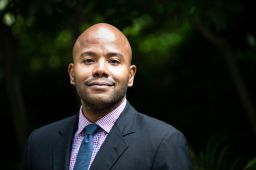Editor’s Note: Peniel E. Joseph is the Barbara Jordan chair in ethics and political values and the founding director of the Center for the Study of Race and Democracy at the LBJ School of Public Affairs at the University of Texas at Austin, where he is also a professor of history. He is the author of several books, most recently “The Sword and the Shield: The Revolutionary Lives of Malcolm X and Martin Luther King Jr.” The views expressed here are his. View more opinion articles on CNN.
Americans are living through truly historic times: the Covid-19 pandemic, protests catalyzed by the killings of George Floyd and Breonna Taylor, the national embrace of Black Lives Matter 2.0, and the specter of black-clad federal law enforcement officers engaging in pitched battles against peaceful mothers purposefully dressed in white, all of which can be refracted through America’s original sin of racial slavery.

Americans are living in an era when efforts to forge a new national identity — what Dr. Martin Luther King Jr. characterized as a “beloved community” free of racial injustice — are directly confronting deeply entrenched national myths rooted in white supremacy. We are in the midst of what amounts to America’s Third Reconstruction.
In the wake of the Civil War, the architects of Reconstruction (1865-1877) made a valiant attempt to create a new interracial democracy. It faltered in the face of brutal violence, legal decisions that assaulted Black citizenship, and a political system that reinforced racial divisions thought to have been eradicated after the war. In the years that followed, segregationists erected Confederate monuments, massacred Black towns, and imposed a version of American history rooted in vicious racist myths that became part of our national culture.
Movies such as “Birth of a Nation” (1915) and “Gone With the Wind” (1939), racist memorabilia such as lawn jockeys, and everyday items such as Aunt Jemima syrup and Uncle Ben’s rice reflected not only personal indignities but wider injuries related to policies and systems of racial oppression.
America’s Second Reconstruction, the civil rights movement’s heroic period in the 1950s and 1960s, attempted to combat the symbols and substance of white supremacy and anti-Black racism, but its mission – despite watershed legal and legislative victories like Brown v. Board of Education and the Civil Rights, Voting Rights and Fair Housing Acts – remains incomplete.
America’s Third Reconstruction began with the soaring promise of Barack Obama’s 2008 presidential election and the victory of a campaign that millions took to be a definitive symbol of historic racial progress.
Dreams that a Black president could prove transformative to national race relations proved short-lived, and the emerging Black Lives Matter movement during Obama’s second term exposed the limited impact of a Black First Family on entrenched systems of oppression.
The 2016 election of Donald J. Trump revealed the depth and breadth of racial resentment and fear among those who correctly interpreted the phrase “Make America Great Again” as a call for a restoration of white supremacy: the “Redeemer South” of Reconstruction, devoted to the removal of gains made by African Americans, updated for a digital age.
This year has ushered in the most dynamic social movement for racial justice in American history as Black Lives Matter 2.0 awakened the entire nation to a reality of White supremacy – made more legible to millions of White Americans who, in the context of the Covid-19 pandemic, shelter-in-place orders and mass unemployment showed new layers of empathy in taking the streets to protest against the killing of George Floyd.
If 2008 reflected hopes that one Black leader could transform racial injustice from the inside out, 2020 bears witness to the power of millions of Americans seeking fundamental transformation of systems of racial injustice from the bottom up.
This year of plague, racial justice protest, and violence has hastened America’s moral and political reckoning with over a century of longstanding monuments, citadels, and symbols of White supremacy that have narrated myths about our nation’s collective past.
The 1619 Project, the New York Times’ multimedia history of racial slavery and democracy since the arrival of the first enslaved African in Jamestown Colony, Virginia, has become the latest battleground in our long running cultural war over the very meaning of freedom, democracy and citizenship.
Conceived by Pulitzer Prize-winning journalist Nikole Hannah-Jones, the project sought to uncover the deep and broad roots of racial slavery and its aftermath on American democracy in ways that have been forgotten, ignored and distorted.
Published in August 2019, the 1619 Project quickly went viral, becoming a much-needed teaching tool to help public school teachers avoid glossing over America’s brutal history of racial slavery and Jim Crow.
The project brilliantly explored slavery’s relationship with capitalism, the creation of a racial caste system and the perpetuation of disparities in wealth and health care that are based on systems rooted in bondage.
Readers of the 1619 Project come away with a better and historically sophisticated understanding of how slavery fostered supply chains of power and privilege for Whites and misery and grief for Blacks – in ways that have received dedicated scholarly attention but comparatively scant public debate.
Tom Cotton, the US senator from Arkansas who publicly called for the use of military troops to route racial justice protesters in the spring, has introduced legislation designed to prevent the teaching of the 1619 Project in public schools.
In denouncing the 1619 Project as anti-American, he characterized slavery as a “necessary evil” that the founders realized would be ended one day, citing Abraham Lincoln as validating this perspective (comments he later tried with dubious success to walk back).

The poverty of Cotton’s historical explanation is surpassed by the mendacity of his description of racial slavery – a practice which slaughtered, maimed, killed, raped and crushed the bones, but not the spirits, of generations of Black human beings.
The Civil War’s gruesome death toll of more than 600,000 Americans obliterates his assertion that the founders realized that slavery would one day be removed from the face of the republic.
Slavery, far from being an inevitable or “necessary evil,” proved to be a system that flourished thanks to thousands of personal, political and policy choices made during the antebellum era and that the 1619 Project rightfully exposed as the brutal progenitor of contemporary systems of mass incarceration, segregation and poverty that persist to this day.
Lincoln’s soaring and concise second inaugural address in 1865, in which he observed that “every drop of blood drawn by the lash, shall be paid by another drawn with the sword” remains a testament to the high price paid to settle, once and for all, whether the United States would embrace freedom or slavery, since the war reflected that a house divided against itself proved destined to fall.
Parts of America still remain divided against itself. Cotton’s efforts to impugn the 1619 Project form the latest effort in a war over the narrative that began as soon as the Civil War ended.
While the North won the physical battle, the South proved victorious in retelling the story of racial slavery to future generations. The “Lost Cause” has proven tenacious enough that even 21st century schoolchildren are frequently taught that the Civil War was fought over “states’ rights” instead of racial slavery.
The 1619 Project refutes this hollow narrative victory with a national history that reflects the bitter fruits of racial slavery and violence as well as the beauty of generations of Black Americans who helped reimagine democracy with an indefatigable will.
Slavery represented an incomprehensible moral and political evil, one that the founders, subsequent presidents, abolitionists and enslaved Black Americans wrestled and debated – but it was never a necessary one.
Suggesting otherwise perpetuates the acceptance of slavery’s legacy. To believe otherwise is to endorse the continuation of a seemingly unbroken chain of wrong turns and bad choices made collectively by a nation that has remained, until as recently as a few months ago, willfully blind to the racial sins of the past.
Cotton’s words remind us that a “narrative war” continues in our own time. The culture wars of the 21st century, like past conflicts, centered around public interpretations of history as a tool to make sense of the present in service of envisioning the country’s political future.
Get our free weekly newsletter
America’s Third Reconstruction, like its two earlier iterations, represents a time for choosing moral sides. Millions of Americans across the nation have and are continuing to do so in unprecedented numbers of demonstrations, protests, and marches advocating racial and social justice.
The choice ahead of us is as stark now as it was on the eve of the Civil War. America can choose a liberated future that acknowledges past racial sins in a generational effort at atonement and repair – or we can double down on the same willful blinders that got us in this mess, aided by rationalizations that describe incomprehensible evil as the cost of doing business.







